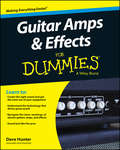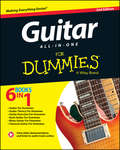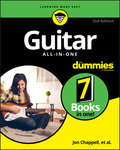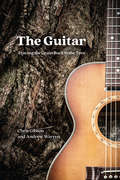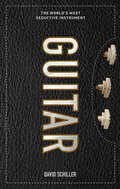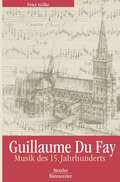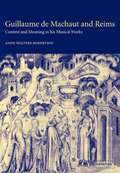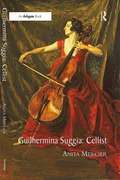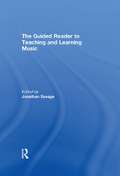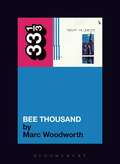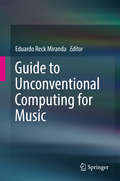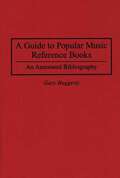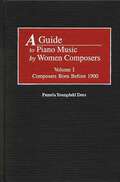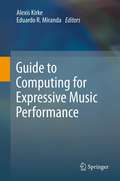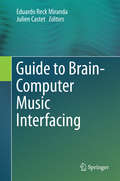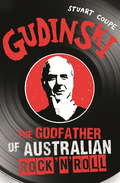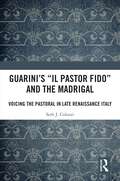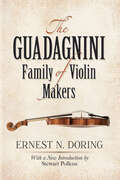- Table View
- List View
Guitar Amps and Effects For Dummies
by Dave HunterLearn the secrets to achieving your ultimate sound Whether amateur or pro, guitarists live for the ultimate sound. Guitar Amps & Effects For Dummies provides the information and instruction you need to discover that sound and make it your own! Written in the characteristically easy-to-read Dummies style, this book is ideal for beginners and experienced musicians alike, and can help all players expand their skill set with effects. Guitarists tend to be gearheads when it comes to sound, and this book provides guidance on topics ranging from the guitar itself to amps, pedals, and other sound technology. Amps and effects are the unsung heroes of guitar music. While most people recognize the more psychedelic effects, many don't realize that effects are often responsible for the unique quality of tone that can become a musician's trademark. Certain effects work on the volume or signal level, others work on the environment, and still others work on the bass and treble content. Guitar Amps & Effects For Dummies covers them all, and shows how effects can not only add something extra, but also "fix" problematic areas. Topics include: Gain-based effects, like distortion, compression, volume pedals, and gates Tone-based effects, including graphic and parametric EQ, and the wah-wah pedal Modulation effects, like the flanger, phase shifter, and tremolo Ambience effects, including reverb and delay The journey to incredible guitar music never ends. No matter how experienced you are with a guitar, there is always room for improvement to your tone and sound. Whether you're looking for the sound of angels or thunder, Guitar Amps & Effects For Dummies will help you achieve the music you hear in your dreams.
Guitar Amps and Effects For Dummies
by Dave HunterLearn the secrets to achieving your ultimate sound Whether amateur or pro, guitarists live for the ultimate sound. Guitar Amps & Effects For Dummies provides the information and instruction you need to discover that sound and make it your own! Written in the characteristically easy-to-read Dummies style, this book is ideal for beginners and experienced musicians alike, and can help all players expand their skill set with effects. Guitarists tend to be gearheads when it comes to sound, and this book provides guidance on topics ranging from the guitar itself to amps, pedals, and other sound technology. Amps and effects are the unsung heroes of guitar music. While most people recognize the more psychedelic effects, many don't realize that effects are often responsible for the unique quality of tone that can become a musician's trademark. Certain effects work on the volume or signal level, others work on the environment, and still others work on the bass and treble content. Guitar Amps & Effects For Dummies covers them all, and shows how effects can not only add something extra, but also "fix" problematic areas. Topics include: Gain-based effects, like distortion, compression, volume pedals, and gates Tone-based effects, including graphic and parametric EQ, and the wah-wah pedal Modulation effects, like the flanger, phase shifter, and tremolo Ambience effects, including reverb and delay The journey to incredible guitar music never ends. No matter how experienced you are with a guitar, there is always room for improvement to your tone and sound. Whether you're looking for the sound of angels or thunder, Guitar Amps & Effects For Dummies will help you achieve the music you hear in your dreams.
Guitar All-In-One For Dummies
by Hal Leonard Corporation Jon Chappell Mark Phillips Desi SernaMake your music come alive with this indispensable guitar guide There's no denying that guitar players have cachet. The guitar is an ever-present part of our collective musical heritage, and the sound can be sensual, aggressive, or a million things in between. Whether you're hoping to conquer Free Bird, Bourée, or Bolero Mallorquin, you need to learn to walk before you can run. Even once you can run, you need something to help you clear hurdles along the way. That's where Guitar All-In-One For Dummies, 2nd Edition, comes in. It's your complete compendium of guitar instruction, written in clear, concise For Dummies style. It covers everything from positioning and basic chords to guitar theory and playing styles, and even includes maintenance advice to keep your instrument sounding great. It's an amazing resource for newbies and veterans alike, and offers you the opportunity to stretch beyond your usual genre. Forge the sound of rock, blues, classical, and more Understand the music theory behind guitar mastery Express yourself through your own compositions Perform practice exercises for muscle memory and dexterity Guitar All-In-One For Dummies, 2nd Edition, includes access to audio tracks and instructional videos to guide you through the lessons and inspire you to play often, which is the number-one key to success. You get advice and instruction from some of the most respected guitar teachers in the business, plus online resources, for less than the cost of a single lesson. Guitar All-In-One For Dummies, 2nd Edition, is the key to bringing your music to life.
Guitar All-In-One For Dummies
by Hal Leonard Corporation Jon Chappell Mark Phillips Desi SernaMake your music come alive with this indispensable guitar guide There's no denying that guitar players have cachet. The guitar is an ever-present part of our collective musical heritage, and the sound can be sensual, aggressive, or a million things in between. Whether you're hoping to conquer Free Bird, Bourée, or Bolero Mallorquin, you need to learn to walk before you can run. Even once you can run, you need something to help you clear hurdles along the way. That's where Guitar All-In-One For Dummies, 2nd Edition, comes in. It's your complete compendium of guitar instruction, written in clear, concise For Dummies style. It covers everything from positioning and basic chords to guitar theory and playing styles, and even includes maintenance advice to keep your instrument sounding great. It's an amazing resource for newbies and veterans alike, and offers you the opportunity to stretch beyond your usual genre. Forge the sound of rock, blues, classical, and more Understand the music theory behind guitar mastery Express yourself through your own compositions Perform practice exercises for muscle memory and dexterity Guitar All-In-One For Dummies, 2nd Edition, includes access to audio tracks and instructional videos to guide you through the lessons and inspire you to play often, which is the number-one key to success. You get advice and instruction from some of the most respected guitar teachers in the business, plus online resources, for less than the cost of a single lesson. Guitar All-In-One For Dummies, 2nd Edition, is the key to bringing your music to life.
Guitar All-in-One For Dummies: Book + Online Video and Audio Instruction
by Hal Leonard Corporation Mark Phillips Jon Chappell Desi Serna7 Books in one! Go from the basics to the style you want to play Making beautiful music with your acoustic or electric guitar requires practice, patience, and perseverance. A little guidance helps get you on the path to imitating the sounds of your guitar heroes. This friendly guide shares how to get the most out of your time with your guitar. Discover the fundamentals of strumming and playing chords and get an understanding of guitar theory, then delve into the secrets of playing rock, blues, or even classical styles. 7 Books Inside… Learning the anatomy of your guitar Starting with guitar fundamentals Refining your sound and technique Getting to know guitar theory Cranking up your rock guitar style Wailing with the blues Building your classical skills
Guitar All-in-One For Dummies: Book + Online Video and Audio Instruction
by Hal Leonard Corporation Mark Phillips Jon Chappell Desi Serna7 Books in one! Go from the basics to the style you want to play Making beautiful music with your acoustic or electric guitar requires practice, patience, and perseverance. A little guidance helps get you on the path to imitating the sounds of your guitar heroes. This friendly guide shares how to get the most out of your time with your guitar. Discover the fundamentals of strumming and playing chords and get an understanding of guitar theory, then delve into the secrets of playing rock, blues, or even classical styles. 7 Books Inside… Learning the anatomy of your guitar Starting with guitar fundamentals Refining your sound and technique Getting to know guitar theory Cranking up your rock guitar style Wailing with the blues Building your classical skills
The Guitar: Tracing the Grain Back to the Tree
by Chris Gibson Andrew WarrenGuitars inspire cult-like devotion: an aficionado can tell you precisely when and where their favorite instrument was made, the wood it is made from, and that wood’s unique effect on the instrument’s sound. In The Guitar, Chris Gibson and Andrew Warren follow that fascination around the globe as they trace guitars all the way back to the tree. The authors take us to guitar factories, port cities, log booms, remote sawmills, Indigenous lands, and distant rainforests, on a quest for behind-the-scenes stories and insights into how guitars are made, where the much-cherished guitar timbers ultimately come from, and the people and skills that craft those timbers along the way. Gibson and Warren interview hundreds of people to give us a first-hand account of the ins and outs of production methods, timber milling, and forest custodianship in diverse corners of the world, including the Pacific Northwest, Madagascar, Spain, Brazil, Germany, Japan, China, Hawaii, and Australia. They unlock surprising insights into longer arcs of world history: on the human exploitation of nature, colonialism, industrial capitalism, cultural tensions, and seismic upheavals. But the authors also strike a hopeful note, offering a parable of wider resonance—of the incredible but underappreciated skill and care that goes into growing forests and felling trees, milling timber, and making enchanting musical instruments, set against the human tendency to reform our use (and abuse) of natural resources only when it may be too late. The Guitar promises to resonate with anyone who has ever fallen in love with a guitar.
The Guitar: Tracing the Grain Back to the Tree
by Chris Gibson Andrew WarrenGuitars inspire cult-like devotion: an aficionado can tell you precisely when and where their favorite instrument was made, the wood it is made from, and that wood’s unique effect on the instrument’s sound. In The Guitar, Chris Gibson and Andrew Warren follow that fascination around the globe as they trace guitars all the way back to the tree. The authors take us to guitar factories, port cities, log booms, remote sawmills, Indigenous lands, and distant rainforests, on a quest for behind-the-scenes stories and insights into how guitars are made, where the much-cherished guitar timbers ultimately come from, and the people and skills that craft those timbers along the way. Gibson and Warren interview hundreds of people to give us a first-hand account of the ins and outs of production methods, timber milling, and forest custodianship in diverse corners of the world, including the Pacific Northwest, Madagascar, Spain, Brazil, Germany, Japan, China, Hawaii, and Australia. They unlock surprising insights into longer arcs of world history: on the human exploitation of nature, colonialism, industrial capitalism, cultural tensions, and seismic upheavals. But the authors also strike a hopeful note, offering a parable of wider resonance—of the incredible but underappreciated skill and care that goes into growing forests and felling trees, milling timber, and making enchanting musical instruments, set against the human tendency to reform our use (and abuse) of natural resources only when it may be too late. The Guitar promises to resonate with anyone who has ever fallen in love with a guitar.
Guitar: The World's Most Seductive Instrument
by David Schiller&“Schiller delivers a delightful photographic survey of 200 famous and innovative guitars. This volume would make an excellent conversation piece on any guitar enthusiast&’s coffee table.&” — Publisher's Weekly A celebration of the world's most seductive instrument, with large full-color photographs plus lore, players, makers, legends. Inspiring to look through, and—with a slipcase—beautiful to hold.
Guillaume Du Fay: Musik des 15. Jahrhunderts
by Peter GülkeDie Klangwelt des 15. Jahrhunderts - in unseren Ohren wirkt sie fremd. Dabei wurden gerade in dieser Epoche wichtige Weichen für die Entwicklung der europäischen Musik gestellt. Auf der Grundlage der reichhaltigen Quellen zeichnet Gülke Leben und Werk des großen französischen Kirchenmusikers Guillaume Du Fay (ca. 1400 bis 1474) nach. Indem der Autor eine Brücke zwischen der Biografie des Künstlers und den kulturellen Phänomenen jener Zeit schlägt, gelingt es, das musikalische Spektrum der Epoche lebendig werden zu lassen.
Guillaume De Machaut And Reims (PDF): Context And Meaning In His Musical Works
by Anne Walters RobertsonGuillaume de Machaut, renowned fourteenth-century French composer and poet, wrote the first polyphonic Mass and many other important musical works. Friend of royalty, prelates, noted poets and musicians, Machaut was a cosmopolitan presence in late medieval Europe. He also served as canon of the cathedral of Reims, an ancient and influential archiepiscopal see and the coronation site of French kings. This exploration of Machaut's life and work focuses on his music based on ecclesiastical chants: twenty-three motets, the David Hocket, and the Mass of Our Lady. The meaning of his music can often be understood through study of its context in fourteenth-century Reims. Machaut emerges as a composer deeply involved in the great crises of his day, one who skilfully and artfully expresses profound themes of human existence in ardent music and poetry.
Guilhermina Suggia: Cellist
by Anita MercierBorn in 1885 in Porto, Portugal, to a middle-class musical family, Guilhermina Suggia began playing cello at the age of five. A child prodigy, she was already a seasoned performer when she won a scholarship to study with Julius Klengel in Leipzig at the age of sixteen. Suggia lived in Paris with fellow cellist Pablo Casals for several years before World War I, in a professional and personal partnership that was as stormy as it was unconventional. When they separated Suggia moved to London, where she built a spectacularly successful solo career. Suggia's virtuosity and musicianship, along with the magnificent style and stage presence famously captured in Augustus John's portrait, made her one of the most sought-after concert artists of her day. In 1927 she married Dr Jos asimiro Carteado Mena and settled down to a comfortable life divided between Portugal and England. Throughout the 1930s, Suggia remained one of the most respected musicians in Europe. She partnered on stage with many famous instrumentalists and conductors and completed numerous BBC broadcasts. The war years kept her at home in Portugal, where she focused on teaching, but she returned to England directly after the war and resumed performing. When Suggia died in 1950, her will provided for the establishment of several scholarship funds for young cellists, including England's prestigious Suggia Gift. Mercier's study of Suggia's letters and other writings reveal an intelligent, warm and generous character; an artist who was enormously dedicated, knowledgeable and self-disciplined. Suggia was one of the first women to make a career of playing the cello at a time when prejudice against women playing this traditionally 'masculine' instrument was still strong. A role model for many other musicians, she was herself a fearless pioneer.
Guilhermina Suggia: Cellist
by Anita MercierBorn in 1885 in Porto, Portugal, to a middle-class musical family, Guilhermina Suggia began playing cello at the age of five. A child prodigy, she was already a seasoned performer when she won a scholarship to study with Julius Klengel in Leipzig at the age of sixteen. Suggia lived in Paris with fellow cellist Pablo Casals for several years before World War I, in a professional and personal partnership that was as stormy as it was unconventional. When they separated Suggia moved to London, where she built a spectacularly successful solo career. Suggia's virtuosity and musicianship, along with the magnificent style and stage presence famously captured in Augustus John's portrait, made her one of the most sought-after concert artists of her day. In 1927 she married Dr Jos asimiro Carteado Mena and settled down to a comfortable life divided between Portugal and England. Throughout the 1930s, Suggia remained one of the most respected musicians in Europe. She partnered on stage with many famous instrumentalists and conductors and completed numerous BBC broadcasts. The war years kept her at home in Portugal, where she focused on teaching, but she returned to England directly after the war and resumed performing. When Suggia died in 1950, her will provided for the establishment of several scholarship funds for young cellists, including England's prestigious Suggia Gift. Mercier's study of Suggia's letters and other writings reveal an intelligent, warm and generous character; an artist who was enormously dedicated, knowledgeable and self-disciplined. Suggia was one of the first women to make a career of playing the cello at a time when prejudice against women playing this traditionally 'masculine' instrument was still strong. A role model for many other musicians, she was herself a fearless pioneer.
The Guided Reader to Teaching and Learning Music
by Jonathan SavageThe Guided Reader to Teaching and Learning Music draws on extracts from the published work of some of the most influential education writers to provide insight, guidance and clarity about key issues affecting Music teachers. The book brings together key extracts from classic and contemporary writing and contextualises these in both theoretical and practical terms. The extracts are accompanied by a summary of the key ideas and issues raised, questions to promote discussion and reflective practice, and annotated further reading lists to extend thinking. Taking a thematic approach and including a short introduction to each theme, the chapters cover: ? Analysing your own work as a music teacher; Concepts of musicality; Notions of musical development and progression; Pedagogies for teaching music musically; Music inside and outside the school; Formal, informal and non-formal approaches to music education; Productive methods of assessment and transition for music education; Creativity and music education; Supporting the gifted and talented in music; Using ICT within music education. ? Aimed at trainee and newly qualified teachers including those working towards Masters-level qualifications, as well practicing teachers, this accessible, but critically provocative text will be an essential resource for all teachers that wish to deepen their understanding of Music Education.
The Guided Reader to Teaching and Learning Music
by Jonathan SavageThe Guided Reader to Teaching and Learning Music draws on extracts from the published work of some of the most influential education writers to provide insight, guidance and clarity about key issues affecting Music teachers. The book brings together key extracts from classic and contemporary writing and contextualises these in both theoretical and practical terms. The extracts are accompanied by a summary of the key ideas and issues raised, questions to promote discussion and reflective practice, and annotated further reading lists to extend thinking. Taking a thematic approach and including a short introduction to each theme, the chapters cover: ? Analysing your own work as a music teacher; Concepts of musicality; Notions of musical development and progression; Pedagogies for teaching music musically; Music inside and outside the school; Formal, informal and non-formal approaches to music education; Productive methods of assessment and transition for music education; Creativity and music education; Supporting the gifted and talented in music; Using ICT within music education. ? Aimed at trainee and newly qualified teachers including those working towards Masters-level qualifications, as well practicing teachers, this accessible, but critically provocative text will be an essential resource for all teachers that wish to deepen their understanding of Music Education.
Guided By Voices' Bee Thousand (33 1/3)
by Marc WoodworthMarc Woodworth's book covers the album's long and unorthodox period of writing, recording, sequencing, and editing. It includes interviews with members of the band, manager Pete Jamison, web-master and GBV historian Rich Turiel and Robert Griffin of Scat Records. At least sixty-five songs were recorded and considered for the album and five distinct concepts were rejected before the band hit upon the records final form. One late version, very nearly released, contained only a few of Bee Thousand's definitive songs.The rest were left out and nearly ended up in the boxes of cassette out-takes cluttering up Robert Pollard's basement. The story of Guided By Voices transformation from an occasional and revolving group of complete unknowns to indie-rock heroes is very much part of the story behind the making of Bee Thousand.In addition to providing a central account of how the record was made, Woodworth devotes a substantial chapter to the album's lyrics. Robert Pollard's lyrics are described by critics, when they're described at all, as a brand of tossed-off surrealism, as if his verbal sensibility is somehow incidental to the songs themselves. Nothing could be further from the truth. Woodworth offers a sustained discussion of Pollard's work as a writer of often sublime, beautiful, and very human lyrics. The third key section of the book covers aesthetics. Woodworth considers the great appeal of the do-it-yourself nature of Bee Thousand and reflects on the larger importance of the strain of alternative rock for which this record is a touchstone.
Guide to Unconventional Computing for Music
by Eduardo Reck MirandaThis pioneering text/reference explores how innovative new modes of computation may provide exciting new directions for future developments in the music industry, guiding the reader through the latest research in this emerging, interdisciplinary field. This work includes coverage of electronic music compositions and performances that incorporate unconventional interfacing, hacking and circuit bending. Features: presents an introduction to unconventional computing in music; discusses initiatives involving biophysical electronic music, the work of self-styled silicon luthiers, and the intersection of music and quantum computing; introduces the memristor, a new electronic component with the potential to revolutionize how computers are built; reviews experiments and practical applications of biological memristors in music; describes IMUSIC, an unconventional tone-based programming language, which enables the programming of computers using musical phrases; includes review questions at the end of each chapter.
A Guide to Popular Music Reference Books: An Annotated Bibliography (Music Reference Collection)
by Gary HaggertyA guide to locating information on popular music and the people who create it, this volume is designed as a desk reference—to locate answers to specific questions and to direct library users to key resources. More than 400 comprehensive titles are carefully annotated, describing content, scope, and special features. The focus is on the musical styles that have developed measurable commercial success through recordings and live performance. Along with academic titles, many important titles from the popular press are included, as well as selected electronic resources. A necessary reference tool for any library, scholar, student, and popular music buff.The work covers bibliographies, indexes, discographies, dictionaries and encyclopedias, biographical resources, directories, almanacs, yearbooks, and guidebooks on styles that include jazz, swing, Tin Pan Alley, country, gospel, blues, rhythm and blues, soul, rockabilly, rock, heavy metal, musical theater, and film music. Its extensive appendices feature discographies and bibliographies of individual artists and ensembles. A detailed index combining authors, titles, and subjects makes cross-referencing easy. The entries are modeled after the immensely useful The Guide to Reference Books.
A Guide to Piano Music by Women Composers: Volume One, Composers Born Before 1900 (Music Reference Collection)
by Pamela Y. DeesDesigned as a practical reference guide for professional pianists and piano teachers, A Guide to Piano Music by Women Composers, Volume I, is an annotated catalogue of the available piano music in print composed by 144 women born before the 20th century. The work also features biographies and extensive bibliographical information for each composer. Arranged alphabetically by composer into categories including single works, collections, and anthologies, the music is also described in terms of grade level, genre, mood, style characteristics, and technical requirements, and ranges in difficulty from late elementary to virtuoso concert repertoire.Far too many teachers, students, professional musicians, and audiences are unaware of the contributions made by women in music, and of the beauty and merit of their specific compositions. This reference work provides an invaluable addition to the current literature.
Guide to Computing for Expressive Music Performance
by Alexis Kirke and Eduardo R. MirandaThis book discusses all aspects of computing for expressive performance, from the history of CSEMPs to the very latest research, in addition to discussing the fundamental ideas, and key issues and directions for future research. Topics and features: includes review questions at the end of each chapter; presents a survey of systems for real-time interactive control of automatic expressive music performance, including simulated conducting systems; examines two systems in detail, YQX and IMAP, each providing an example of a very different approach; introduces techniques for synthesizing expressive non-piano performances; addresses the challenges found in polyphonic music expression, from a statistical modelling point of view; discusses the automated analysis of musical structure, and the evaluation of CSEMPs; describes the emerging field of embodied expressive musical performance, devoted to building robots that can expressively perform music with traditional instruments.
Guide to Brain-Computer Music Interfacing
by Eduardo Reck Miranda Julien CastetThis book presents a world-class collection of Brain-Computer Music Interfacing (BCMI) tools. The text focuses on how these tools enable the extraction of meaningful control information from brain signals, and discusses how to design effective generative music techniques that respond to this information. Features: reviews important techniques for hands-free interaction with computers, including event-related potentials with P300 waves; explores questions of semiotic brain-computer interfacing (BCI), and the use of machine learning to dig into relationships among music and emotions; offers tutorials on signal extraction, brain electric fields, passive BCI, and applications for genetic algorithms, along with historical surveys; describes how BCMI research advocates the importance of better scientific understanding of the brain for its potential impact on musical creativity; presents broad coverage of this emerging, interdisciplinary area, from hard-core EEG analysis to practical musical applications.
Gudinski: The Godfather of Australian Rock
by Stuart CoupeThe real story of the man behind the bands - and a backstage pass to forty years of Australian rock music.Known to many as GODinski, Michael Gudinski is unquestionably the most powerful and influential figure in the Australian rock'n'roll music business - and has been for the last four decades.Often referred to as 'the father of the Australian music industry', he has nurtured the careers of many artists - Kylie Minogue, Jimmy Barnes, Paul Kelly, Skyhooks, Split Enz, Yothu Yindi, to name just a few. But his reach isn't limited to Australian artists. With his Frontier Touring Company, Gudinski has toured The Rolling Stones, Frank Sinatra, Bob Dylan, Bruce Springsteen, Madonna, Sting ... pretty much a who's who of the arena level international music scene.A self-made multi-millionaire, Gudinski is the Australian equivalent of Richard Branson or David Geffen, but who is this tough, inspired, flamboyant and impassioned businessman who has shaped Australian popular culture? Where did he come from, and how has he stayed relevant for so long in an industry notorious for its fickleness? Rock journalist Stuart Coupe delves into Gudinski's life to find the answers - and in doing so gives us a backstage pass to forty years of Australian rock.
Guarini's 'Il pastor fido' and the Madrigal: Voicing the Pastoral in Late Renaissance Italy
by Seth J. ColuzziBattista Guarini’s pastoral tragicomedy Il pastor fido (1589) began its life as a play, but soon was transformed through numerous musical settings by prominent composers of the late sixteenth and early seventeenth centuries. Through the many lives of this work, this book explores what happens when a lover’s lament is transplanted from the theatrical stage to the courtly chamber, from speech to song, and from a single speaking character to an ensemble of singers, shedding new light on early modern literary and musical culture. From the play’s beginnings in manuscripts, private readings, and aborted stage productions in the 1580s and 1590s, through the gradual decline of Pastor fido madrigals in the 1640s, this book examines how this widely read yet controversial text became the center of a lasting and prolific music tradition. Using a new integrative system of musical-textual analysis based on sixteenth-century theory, Seth Coluzzi demonstrates how composers responded not only to the sentiments, imagery, and form of the play’s speeches, but also to subtler details of Guarini’s verse. Viewing the musical history of Guarini’s work as an integral part of the play’s roles in the domains of theater, literature, and criticism, this book brings a new perspective to the late Italian madrigal, the play, and early modern patronage and readership across a diverse geographical and temporal frame.
Guarini's 'Il pastor fido' and the Madrigal: Voicing the Pastoral in Late Renaissance Italy
by Seth J. ColuzziBattista Guarini’s pastoral tragicomedy Il pastor fido (1589) began its life as a play, but soon was transformed through numerous musical settings by prominent composers of the late sixteenth and early seventeenth centuries. Through the many lives of this work, this book explores what happens when a lover’s lament is transplanted from the theatrical stage to the courtly chamber, from speech to song, and from a single speaking character to an ensemble of singers, shedding new light on early modern literary and musical culture. From the play’s beginnings in manuscripts, private readings, and aborted stage productions in the 1580s and 1590s, through the gradual decline of Pastor fido madrigals in the 1640s, this book examines how this widely read yet controversial text became the center of a lasting and prolific music tradition. Using a new integrative system of musical-textual analysis based on sixteenth-century theory, Seth Coluzzi demonstrates how composers responded not only to the sentiments, imagery, and form of the play’s speeches, but also to subtler details of Guarini’s verse. Viewing the musical history of Guarini’s work as an integral part of the play’s roles in the domains of theater, literature, and criticism, this book brings a new perspective to the late Italian madrigal, the play, and early modern patronage and readership across a diverse geographical and temporal frame.
The Guadagnini Family of Violin Makers
by Ernest N. Doring Stewart PollensAlong with the instruments of Stradivari and del Gesù, the violins of Giovanni Battista Guadagnini have long been favored by professional musicians for their responsiveness, tonal quality, and projection. Originally published in 1949 in a very limited edition, this study remains the most comprehensive account of G. B. Guadagnini's work and the legacy carried on by his descendants.Author Ernest N. Doring conducted painstaking research into eighteenth-century documentation of Guadagnini's itinerant life. He traces the craftsman's progress from Piacenza, Milan, Cremona, and Parma to Turin, where Guadagnini created his most prized stringed instruments. A catalog of the family's masterpieces is organized by city and provides a detailed provenance for each instrument. A new Introduction by Stewart Pollens, a leading authority on musical instruments, offers historical perspectives. Widely available for the first time in an affordable edition, this rare and authoritative work provides violinists, musicologists, and music history enthusiasts with a fascinating resource.
